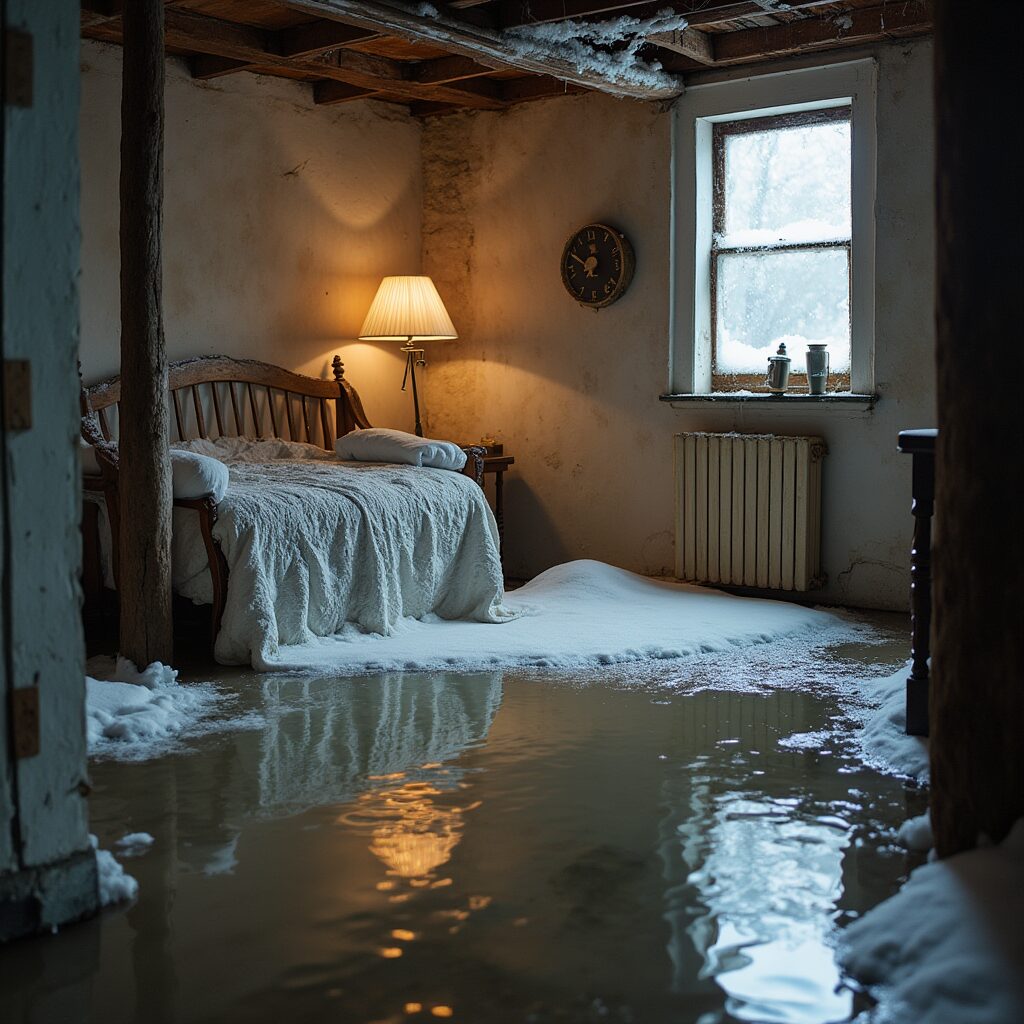
Preventing Basement Flooding During The Winter Season
Winter brings unique challenges that can increase the risk of basement flooding. The combination of snowmelt, frozen pipes, poor drainage, and hydrostatic pressure can lead to costly water damage.
In Canada, water-related property claims are among the most expensive, with homeowners facing repair bills that can reach thousands of dollars. Taking proactive measures before winter hits can help prevent major issues and keep your basement dry throughout the cold months.
Let’s get right into it!
Understanding The Causes Of Basement Flooding In Winter
Rapid snowmelt and freeze-thaw cycles can lead to excessive water accumulation around the foundation, increasing the risk of leaks. Frozen pipes that burst due to expanding ice can release significant amounts of water into a basement.
Clogged or frozen gutters prevent proper drainage, forcing water to pool near the foundation. Hydrostatic pressure increases when soil around the home becomes saturated, pushing water through cracks in basement walls and floors. Poor basement insulation allows cold air to enter, increasing the likelihood of condensation and moisture buildup.
Ensure Proper Grading And Drainage Around Your Home
If the land around a home slopes toward the foundation, water will naturally flow into the basement. Proper grading ensures that water moves away from the house, reducing the risk of seepage.
Adding compacted soil or gravel around the home can help maintain a downward slope of at least six inches over ten feet. Window wells should be checked to ensure they are properly sealed and have functional drainage systems to prevent water from pooling.
Clean Gutters And Downspouts To Prevent Ice Dams
Gutters and downspouts play a crucial role in directing water away from the home. Clogged gutters cause water to overflow, leading to ice buildup that can force water under the roof and into the foundation. Before winter, all leaves, debris, and ice should be cleared from gutters to maintain proper drainage.
Downspouts should extend at least six feet away from the house to prevent water from pooling near basement walls. Installing gutter guards can help minimize debris buildup and reduce maintenance.
Install And Maintain A Sump Pump System
A sump pump is an essential tool for preventing basement flooding by actively removing excess groundwater. Ensuring the pump is in working condition before winter can help avoid emergency situations. Sump pumps should be tested by pouring water into the pit to see if the system activates properly.
A battery backup system is highly recommended to keep the sump pump functional during power outages, which are common during winter storms. Sump pump failures are often caused by clogged discharge lines or frozen pipes, so regular maintenance is necessary.
Insulate Pipes To Prevent Freezing And Bursting
Pipes that run through unheated areas, such as basements, crawl spaces, and garages, are at high risk of freezing.
Insulating pipes with foam sleeves, heat tape, or fibreglass wrap helps prevent freezing and bursting. Keeping the basement temperature above 12°C can further protect pipes from freezing. If a pipe does freeze, applying gentle heat using a hairdryer or heating pad can help thaw it safely.
Seal Foundation Cracks And Basement Walls
Small foundation cracks can expand during winter due to the freeze-thaw cycle, allowing water to seep inside. Sealing cracks with epoxy injections or waterproof sealants can help prevent leaks.
Applying a waterproof membrane to basement walls provides an additional layer of protection against moisture infiltration. If significant foundation cracks are present, consulting a professional is recommended to assess and repair structural issues.
Improve Indoor Air Circulation And Dehumidification
Poor air circulation can lead to excess humidity and condensation, increasing the risk of mould and mildew. Proper ventilation is essential in maintaining a dry basement environment. Running a basement dehumidifier, even in winter, can help control moisture levels.
Ensuring heating ducts are open and air is evenly distributed throughout the home helps prevent cold spots that contribute to condensation.
Install A Backwater Valve To Prevent Sewage Backup
Winter storms and frozen sewer lines can lead to sewage backups, causing severe basement flooding. A backwater valve prevents sewage from flowing back into the home by automatically closing when reverse flow is detected.
Regular inspections and cleaning of backwater valves ensure they function properly during heavy rainfall or snowmelt. Some municipalities offer rebates for backwater valve installations as part of flood prevention programs.
Check And Maintain Your Home’s Weeping Tile System
A weeping tile system helps direct groundwater away from the foundation, reducing hydrostatic pressure. Over time, these drainage systems can become clogged with sediment and debris, leading to basement leaks.
Signs of a failing weeping tile system include persistent dampness, musty odours, and visible cracks in basement walls. Cleaning and maintaining the system regularly helps ensure proper drainage and prevents water accumulation around the home.
Monitor Snow Accumulation Around Your Home
Heavy snow accumulation around the foundation can increase the risk of flooding once temperatures rise.
Clearing snow from the perimeter of the house helps prevent excessive water runoff. Roof snow should also be removed safely to prevent ice dams that can lead to interior leaks. Heated driveways and walkways can help reduce ice buildup and minimize the risk of water pooling near the foundation.
Insurance And Financial Considerations For Winter Basement Flooding
Most home insurance policies cover sudden and accidental water damage, including basement flooding caused by burst pipes or sump pump failures. However, damage resulting from neglect, such as failing to maintain gutters or leaving a home unheated, may not be covered.
Homeowners should document any flooding incidents with photos and contact their insurance provider immediately to file a claim. Installing flood prevention measures, such as sump pumps and backwater valves, can help lower insurance premiums. Some municipalities offer grants and rebates for flood prevention upgrades, making it worthwhile to explore available financial assistance.
FAQs Preventing Basement Flooding In Winter
How do I know if my basement is at risk of flooding during winter?
Homes with poor drainage, cracked foundations, clogged gutters, or inadequate sump pump systems are more likely to experience basement flooding.
What should I do if I find small cracks in my basement walls?
Sealing cracks with waterproof epoxy or hydraulic cement can prevent water from seeping in, but large cracks should be inspected by a professional.
Can basement flooding be prevented without a sump pump?
Proper grading, waterproofing, and drainage systems can help reduce flooding risks, but a sump pump is an effective additional measure.
How often should I test my sump pump system?
Sump pumps should be tested every three months and before winter by pouring water into the pit and checking if the system activates.
What is the best way to thaw frozen pipes to avoid flooding?
Applying gentle heat using a hairdryer or warm towels can safely thaw frozen pipes, but never use an open flame.
How much snow around my home is too much before it becomes a flood risk?
If snow accumulation reaches over 30 cm near the foundation, it should be cleared to prevent excessive water runoff.
Can poor attic insulation contribute to basement flooding?
Yes, poor attic insulation can lead to ice dams that cause water to seep down walls and into the basement.
What are the early warning signs of foundation leaks in winter?
Damp spots, musty odours, and white powdery residue on basement walls are signs of water infiltration.
Do backwater valves really prevent all types of sewer backups?
While they significantly reduce the risk, they require proper maintenance to function effectively.
Should I invest in professional basement waterproofing or do it myself?
Small cracks and minor leaks can be sealed as DIY projects, but professional waterproofing is recommended for serious foundation issues.
Conclusion
Basement flooding can be a costly and stressful problem, but taking preventive measures can significantly reduce the risk. Proper grading, drainage maintenance, insulation, and sump pump upkeep are key to keeping basements dry during winter.
Homeowners should act before the first snowfall to ensure their home is protected from water damage. A proactive approach not only prevents costly repairs but also safeguards property value and overall home integrity.
If you have any questions about our article, “Preventing Basement Flooding During The Winter Season” or need water damage restoration services contact us at 1-833-WE-DRY-IT any time 24/7/365 all the time or connect with us on social media, we’re there when you need us!
Related Posts
Water Damage Restoration Articles
What you can expect from a fire damage restoration company
Water damage prevention tips from the most common problems we’ve seen
Top causes of water damage in commercial buildings and how to find them
Must-know water damage tips: What to do after your house floods
What does good water damage restoration look like?
DIY water damage restoration and the hidden dangers
How to choose the right water damage company
Flast floods: What to do before, during and after a flash flood
What to do when your attic leaks?
Mould Removal Restoration Articles
5 Signs You Have Mould Growing In Your Walls
“Can I Remove Mould Myself?” Our Mould Removal Experts Have Answers
7 Must-Know Reasons Why You Should Get A Mould Inspection Before Buying A House
Does Mould Attract Bugs? Yes And Here’s What Kind And Why
How To Remove Mould From The Attic [Mould Prevention Tips Inside]
How Rain Causes Mould Growth-Prevention Tips Included
Must-Know Tips: How To Remove Mould In Your Basement
Fire Damage Restoration Articles
How to clean up after a house fire
Fire damage restoration checklist
Fire damage tips: 6 hazards property owners miss
How smoke from fires can negatively affect your health
What are the most common causes of house fires?
10 helpful smoke damage cleaning tips
Related Water Damage Services
Fire damage restoration services
Water damage restoration services
Emergency cleanup services
Mould removal services
Weather damage services


